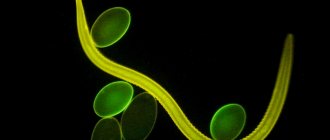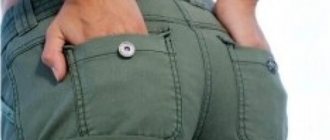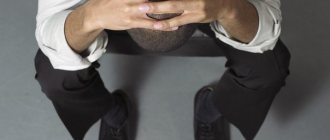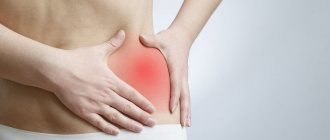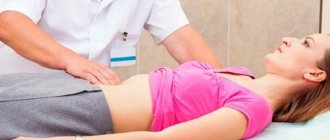Anal fissure
The occurrence of an anal fissure is associated with a violation of the structure of the mucous membrane of the anus. It is usually formed on its back wall, 1-2 centimeters long, the width and depth usually does not exceed a few millimeters. Factors that can provoke such a change are injuries to the anal area, a tendency to constipation, stress when lifting and carrying heavy objects, playing “heavy” sports, and the presence of a source of infection in the body. In women, such a crack forms during childbirth, in the postpartum period.
Why do such problems occur in a healthy woman:
- Muscle spasms. This problem usually affects teenagers. The muscles of the anus involuntarily contract during sleep, causing the girl to experience pain. With age, this problem disappears by itself.
- Uncomfortable chair. A hard seat can ruin your day as much as any illness. It’s easy to get rid of the problem - put a soft scarf on the seat or change the chair. In general, to prevent such pain, doctors recommend moving more and doing less sedentary work.
- Pain in the anus in women often appears during menstruation. Every woman has peculiarities in the structure of her body; if the uterus is located closer to the back, then most likely the girl will complain of similar pain.
- Pregnancy is a difficult period. Many girls at this time begin to complain of pain in the anus. During the growth of the embryo, the uterus increases in size and begins to put pressure on neighboring organs. This is why pregnant women need to go to the toilet so often. If a girl sits or sleeps on her back a lot during pregnancy, the nerves in the rectum are compressed. That's why girls complain about pain.
Complaints of pain in the anus are a sign of a whole list of various problems in the body. In women, this is often associated with inflammation of the genital organs or injury. It also hurts in more serious cases, for example, if rectal cancer develops. Nerve endings can be pinched due to the incorrect structure of the pelvis. And even ordinary osteochondrosis can cause problems. It hurts in the rectal area if it affects the lower back.
If you have complaints of pain in the anus, then most likely you have hemorrhoids. This disease is associated with inflammation of the hemorrhoidal veins. After some time, you can feel the fallen nodes without a special examination, as the disease progresses over time. Despite popular misconception, hemorrhoids do not start with pain.
Bleeding when going to the toilet can also occur with the second most popular problem - acute anal fissure. This problem causes pain directly in the sphincter area. Essentially, this is a scratch on the wall of the sphincter. When you relieve yourself, feces additionally irritate and injure the sore spot.
The cause of anal fissure can be prolonged diarrhea or, conversely, constipation, as well as the presence of undigested pieces of food, such as bones, in food. Since there are many nerve endings in the anus, the pain is very disturbing, and over time it can spread to neighboring organs.
Injuries, including during anal sex, are not the last cause of such pain. If you injure the perineum, the anus will also hurt. If you engage in anal sex without the necessary preparation, you risk discovering a new anal fissure. This is eloquently signaled by problems with the toilet - it hurts to relieve oneself, irritation appears.
If you have hemorrhoids, anal sex is not the best choice, as this can give impetus to the further development of the problem. In addition, if you have problems with the rectum, you should choose positions for traditional intercourse so that there is no tension in the anus. Sports activities that involve lifting weights should also be avoided.
The intestines will work better during physical activity, but it is better to focus on running, gymnastics or swimming. Those sports that do not cause overstrain in the rectum.
When any problem appears chronically, it indicates serious problems. Chronic pain is a clear sign that some pathological process is going on in the body. In this case, pain is not the only symptom, and we can talk about a certain clinical picture.
- Inflammation of the mucous membrane. When it appears in the rectum, they usually say that the woman is suffering from papillitis. The main symptoms are burning and general discomfort in the sore spot. Often patients allegedly feel something at the site of inflammation, as if a foreign body is stuck there. It may not hurt all the time, but it gets worse during certain periods.
- Chronic paraproctitis is an inflammation of the fat cells around the rectum. In fact, wen and fistulas form in the perineal area. During an exacerbation, such swelling can be easily detected by yourself, without the help of a specialist. Patients suffer from malaise, the temperature stays around 37 degrees for a long time. The pain is felt locally, in one place. When the exacerbation passes, there are no external signs of the disease.
- Malignant tumors are the least desirable diagnosis for a patient. Cancer may not cause acute symptoms for many years, but the disease does not go away without symptoms. The severity of pain depends little on the stage of the disease. A small tumor without metastases can be very painful, while at the last stage a rectal tumor occurs with virtually no pain. Regular bleeding when going to the toilet can be alarming. The pain spreads to neighboring areas over time.
- Appendicitis gives pain not only in the side. For each person, this process is located individually. Depending on the location, different parts of the body may hurt, not least the anus in women. The pain is severe and is accompanied by characteristic symptoms - the temperature rises, the patient feels sick, as with general intoxication. Any specialist can detect the problem during an examination, so it is especially important to get to the hospital on time.
- Diseases of the genital organs. The pain is concentrated in the lower abdomen and radiates to the anus. That is why, when women complain of pain in the anus, they are referred to a gynecologist for examination. In this case, serious pathologies can be detected, such as ovarian cysts or cervical cancer. When there is pain due to a cyst, the cyst is usually large in size and puts pressure on the intestines.
- Sexually transmitted diseases are a common cause of chronic pain in the anus in women. The problem can be identified by other signs, such as a rash in the labia and anus. It is not uncommon to experience vaginal discharge or cloudy urine.
Tingling in the anus with pain, burning and discomfort occurs for a number of reasons. These may be signals from developing pathologies.
Pain in the anus
- inadequate hygiene;
- hemorrhoidal disease;
- injury to the rectum or mucous membranes;
- dysbacteriosis;
- parasitic diseases;
- diabetes;
- excess weight;
- oncology.
Pain in the anus due to oncological causes occurs due to the proliferation of tissues that put pressure on the nerve roots and blood vessels. Defecation becomes difficult, blood appears in the stool, and after using the toilet there is burning and pain in the anus.
A burning sensation in the anus is felt in women due to injuries to the vagina, uterus, or with a fungal infection (candidiasis).
An unpleasant and often dangerous symptom, pain in the anus, can also occur for other reasons. The list of diseases and pathological conditions is supplemented by:
- injuries;
- tendency of the rectum to prolapse;
- intestinal polyposis;
- acute proctitis and paraproctitis;
- cryptite;
- papillitis in the anus;
- diseases transmitted through sexual intercourse;
- growth of condylomas around the anus;
- dysfunction of the urinary organs.
In men, the anus area hurts when prostatitis develops. In women, the symptom is observed during pregnancy, indicating a possible ectopic pregnancy, rupture of an ovarian cyst, and is characteristic of endometriosis or adnexitis. Aching, dull pain in the anus often precedes menstruation.
Traditional medicine in the fight against disease
A burning sensation in the anus can be relieved with natural remedies at home. There are many ways to do this in folk medicine.
Sitz baths
The burning sensation of hemorrhoids is relieved by a sitz bath. The session improves microcirculation and accelerates tissue regeneration in the anal area.
Baths for hemorrhoids
- fill the basin with water (warm) - 2 liters;
- sit in the container for a quarter of an hour (the anus should be completely covered with water);
- the anal area is wiped dry;
- The session is carried out three times a day.
You can cure the skin with baths with the addition of medicinal herbs (decoctions). To do this, infusions made from tansy, marigold, and chamomile are added to the bath.
Treatment with oatmeal
Oatmeal has long been used to relieve itching on the body, including the anal area. Oatmeal contains components that cleanse the skin, relieve inflammation and itchy symptoms. The product is used for eczema, psoriasis, and yeast infections. Oatmeal water moisturizes the epidermis and relieves itching.
You can relieve pain and unbearable burning in the anus by taking a bath using oatmeal:
- 400 ml of oatmeal is added to the filled (hot) bath;
- the ingredient is mixed in water;
- the procedure is carried out for 25 minutes, during which time the skin will steam;
- while lying in the bathroom, you can take a small handful of oatmeal and apply it to the passage, pressing on the anus;
- After the procedure, the anus is blotted with a cotton napkin.
The session is carried out three times in 7 days, until the discomfort completely disappears.
The use of the gel is a healing therapy for hemorrhoids. Treatment of burning in the anus is due to the nutrition of the epidermis. The natural component contains many useful components. The drug has anti-inflammatory potential and has a more positive effect than many medications for hemorrhoids.
The anus is washed and dried with a napkin using blotting movements. The juice is squeezed from an aloe leaf and rubbed into the affected area. Instead of juice, you can use aloe vera gel. Treatment is done 2-3 times a day.
Vinegar for hemorrhoids
If you feel a burning sensation in the rectum during bowel movements, you can relieve the unpleasant symptoms with apple cider vinegar. The product eliminates itching and discomfort. This is due to the effects of the acid contained in the product. The acid lowers the pH level, which is too high on irritated skin.
Apple cider vinegar can help kill a yeast infection (candidiasis). The product has increased antifungal activity. If the cause of the burning anal passage is a yeast infection, eczema, psoriasis, a diluted raw product is used. To eliminate bacterial flora, use a diluted product 1 to 1 with water. The procedure is carried out like this.
A ball is made of cotton material or gauze, urinated in the prepared composition and applied to the anus. To relieve disturbing symptoms, you should hold this lotion for 8-10 minutes. During this time, not only the discomfort is eliminated, but the infection is also destroyed. You can perform 3 procedures per day.
Coconut oil
Both oils have an antifungal effect, which quickly relieves burning and discomfort in the posterior canal. The coconut product contains fatty acids that moisturize the skin. For example, with eczema and psoriasis, it is necessary to moisturize the epidermis due to its dryness. By using coconut oil, patients lose the desire to scratch itchy areas.
The benefits of tea tree ether and its antimicrobial effects have been known for a long time. The component is used to combat fungi. If you add a few drops of tea tree ether to a coconut product, you will get an excellent antimicrobial, moisturizing remedy against itching and burning in the rectum.
To prepare the medicinal composition, mix 2 tbsp. l. coconut product with 3 drops of tea tree ether. An itchy anus is lubricated by rubbing it into the affected area. The procedure is repeated 3 times a day. The course of treatment is until the unpleasant symptoms disappear completely.
Compresses
To make a compress for a burning sensation in the posterior canal, you need a bandage and a decoction of chamomile, periwinkle leaves, and calendula. All components are taken in equal quantities, 20 g of raw materials are taken from the resulting mass, 200 ml of boiled water is poured in, and kept for 25 minutes in a water bath. The broth is filtered, cooled, a gauze napkin is soaked in it, and applied to the anus. The procedures are performed daily; after the treatment session, the anus is lubricated with olive oil.
Washing
Maintain hygiene
A burning sensation in the anus caused in women due to thrush is treated by washing with medicinal herbs in combination with douching. The solution is prepared from 1000 ml of boiled water, half a tablespoon of soda, the same amount of salt and 2 tablespoons of peroxide. Washing and douching are carried out twice a day, in the morning and evening. As a syringe and wash, you can use a decoction of a mixture of herbs: chamomile, marigold, acacia.
Diseases of the rectum are treated with sea buckthorn oil; a suppository of soap is placed at night for household needs. For hemorrhoids, a gruel of raw, grated potatoes is used, after a compress, the anus is treated with sea buckthorn oil.
- Temperature after varicocele surgery
- Pus for hemorrhoids and after surgery: treatment of purulent hemorrhoids
- Adhesive bowel disease symptoms after surgery
- Intestinal dysbiosis: symptoms and treatment in adults after antibiotics
Symptoms
Pain, itching in the anus can be acute or dull. The symptoms are aggravated by a burning sensation in the rectum when sitting. Tingling in the anus is felt when walking.
Complications of hemorrhoids
- constipation or diarrhea;
- overthrow;
- bloody discharge;
- mucus with pus;
- feeling that there is something in the rectum (symptom of hemorrhoids).
After determining the cause of the pathological condition, the specialist prescribes effective treatment, taking into account the stage and course of the disease.
Causes
At the moment of defecation, a spasm of smooth muscles occurs, allowing the feces to be expelled. In the case of stagnant processes or inflammation, this process can be painful. The most common reasons for discomfort and pain after visiting the toilet in a big way are:
- prolonged sitting on a hard surface, which provokes metabolic disorders in the lower intestine;
- inflammation of the genitourinary system;
- anal fissures, which serve as an open door for various viruses and bacteria that can provoke an inflammatory process;
- sedentary lifestyle and obesity;
- unhealthy diet consisting of rough food;
- lack of water in the body, which complicates the process of digestion and absorption of food;
- lack of physical activity, as a result of which smooth muscles lose their tone.
Some diseases that occur in a chronic form can also contribute to the appearance of pain after defecation in the lower abdominal segment. Let's look at these reasons in more detail.
Anal vein thrombosis
A complication of hemorrhoids, in which severe pain occurs in the anus, is thrombosis of the veins of the anal area. The mechanism of its development consists of several points. First, in the section of the rectum where the characteristic lump appears, the inner wall of the vessel is damaged. Here a blood clot begins to form and grow, which interferes with normal blood flow, causes congestion in the vessel, then a focus of inflammation and swelling appears. Such changes are accompanied by constant discomfort. Excruciating pain makes the process of bowel movement very difficult.
Diagnostics
Prolapsed hemorrhoid
The feeling of painful discomfort in the anus should be diagnosed by a proctologist. The doctor examines the anus and sacrococcygeal area. If it stings in the butt, it may be polyposis (polyps), a specialist examines the rectum for growths. The condition of the anus is assessed (retracted, flat, closed). Pain and itching in the anus are often caused by hemorrhoids.
At the next stage, a digital examination of the condition of the tissues is carried out for the functioning of the sphincter, mobility, and elasticity of the mucous membranes. Palpation determines the presence of cracks, paraproctitis, scarring, the presence of neoplasms, etc.
Sometimes it is necessary to examine other specialists: gastroenterologist, dermatologist, gynecologist, venereologist. The doctor also prescribes tests: general blood and urine tests, stool (blood content, worms, state of microflora), biochemistry, scraping around the anal canal.
How to treat pain in the anus
An unpleasant sensation of pain in the anus requires timely treatment. Initially, the pain is mild, then gradually increases and becomes unbearable. Additional symptoms include spasms and burning. In some cases, surgery is required to relieve pain.
For pain in the anus in men, the following therapy is prescribed:
- the circulatory system of the intestines and pelvic organs is strengthened;
- damaged tissue of the vena cava is restored;
- swelling is relieved;
- microcracks and damage heal;
- the condition of the mucous layers and their regeneration improves.
What helps with hemorrhoids (piles)? To eliminate painful sensitivity in the anal area, the following medications are recommended.
- Nigepan.
- Anuzol.
- Posterized.
- Proctosan.
- Olestesin.
Thanks to the astringent substances of the medications, a protective film is formed on damaged veins, soothing itching, accelerating the healing of cracks and mucous epithelium. Cracks can also be healed with the help of rectal medications. Betadine and Relief are powerful antiseptics that prevent infection through wounds.
During the treatment course, it is necessary to take into account the internal state of the blood vessels. For this purpose, venotonics are prescribed - external and internal preparations containing acids that improve microcirculation and eliminate congestion. Among such agents are Heparin ointment, Troxevasin, Hepatrombin, Troxerutin. To strengthen the veins, angioprotectors are used (Detralex, Venarus, Phlebodia 600).
If the anus burns and itches due to a parasitic infection, antiparasitic drugs are prescribed. Medicines are selected taking into account the types of worms based on test results. Dysbacterial itching symptom is treated by taking bifidobacteria, which improve the condition of the microflora.
Causes of pain during bowel movements - constipation
Long-term constipation may also make it painful to pass stool. In case of constipation, the stool is usually heavy, with great effort and pain during bowel movements. Symptomatic pain is accompanied by a feeling of insufficient bowel movement. A serious medical problem affects almost all segments of the working population, regardless of social status. In older people, pain during bowel movements during constipation is 5 times more common than in young and middle-aged people.
The most common causes of constipation in people are:
- Poor nutrition, characterized by a lack of dietary fiber.
- Low physical activity of a person.
- Excessive consumption of laxatives.
- Abnormal development of the colon.
- Mechanical injury to the intestine.
- Hormonal disorders in women.
- Excessive passion for alcohol and carbonated drinks.
- Other clinical and pathological abnormalities.
Treatment tactics for constipation are selected taking into account individual diagnostic indications. Proper nutrition promotes healthy bowel movements. The patient's diet should include:
- raw vegetables and dried fruits;
- Rye bread;
- dairy products;
- well-cooked porridge.
It should be remembered that foods high in tannin, such as blueberries, black tea, red wines, coffee, cocoa and others, contribute to delayed bowel movements. Experts do not recommend self-treatment of constipation with laxatives and various traditional medicines. Any systemic treatment of the intestine should begin with a high-quality diagnostic examination.
Proper nutrition eliminates pain during bowel movements
What may pain accompanying defecation indicate?
When defecating, pain causes discomfort to the patient. The symptom is usually accompanied by pain and burning. This is due to irritation or injury to the mucous membranes of the gastrointestinal tract. Normally, bowel movements occur up to twice a day.
The process of bowel movement takes place without any additional discomfort. Pain during defecation always indicates existing disturbances in the functioning of the gastrointestinal tract. The symptom can be localized in the abdominal cavity or in the anal area.
If discomfort occurs, you should visit a medical facility.
Pain during bowel movements may be a symptom of serious illness
Pain after or during bowel movements cannot occur on its own. The sign always indicates the course of any violations. The symptom can be either periodic or constant. The main provoking factors are described in the table.
| Cracks in the anus | Pain in the anus after defecation is often a consequence of fissures. The anal area is injured due to constipation and diarrhea. With severe discomfort, people subconsciously begin to provoke difficulty in defecating. |
| Neoplasms in the rectum | Discomfort will occur immediately before bowel movement, when fecal matter touches the neoplasm. The pain in this case is pronounced. It is possible that red blood may be present in the stool if the tumor is injured. |
| Menstruation | Pain in the lower abdomen during bowel movements in women occurs during menstruation. There is a high risk of burning around the anus. Fecal matter does not contain blood. The woman feels heaviness in the abdominal cavity and severe weakness. The condition usually normalizes on its own and does not require special treatment. There is no risk of any complications. |
| Acute proctitis | A painful sensation occurs when defecating. Defecation is accompanied by relief and subsidence of discomfort. At an advanced stage of the disease, a feeling of pain in the intestinal tract occurs. |
| Infectious lesions of the intestinal tract | When an infection enters the body, patients almost always experience constipation or diarrhea. The mucous membranes of the gastrointestinal tract begin to become inflamed. It is for this reason that the patient experiences pain during bowel movements. The painful sensation is cramping in nature. There may be a false urge to defecate. There may be blood or pus in the feces. |
| Inflammatory process in the uterus | Pain during bowel movements in women can indicate the development of an inflammatory process in the uterus. A woman may feel fecal matter moving through her intestinal tract. |
| Haemorrhoids | The most common cause of pain in the lower abdomen after bowel movements. Discomfort can also be localized in the anal area against the background of cracks that have arisen. If left untreated, inflamed hemorrhoids can prolapse from the rectum. In the presence of severe pain, the patient may be afraid of defecation. In this case, prolonged constipation will form. Due to the accumulation of feces, toxic substances will begin to spread throughout the body. A number of additional signs will appear. |
The listed provoking factors are the main ones. The diagnosis can be made using complex diagnostics.
To determine the cause of the pain, it is necessary to undergo an examination
Formation of feces occurs in the large intestine. As food particles move through the intestinal tract, water is absorbed. This causes changes in the consistency of stool and its final volume.
The inside of the intestinal tract is covered with mucous membrane. This helps protect the organ from mechanical damage. The urge to defecate is a consequence of irritation of the nerve endings in the gastrointestinal tract.
Pain during defecation may be present in the anal sphincter area or in the abdominal cavity. Discomfort in the anus is caused by injury to the opening. This symptom appears a few days after the bowel disorder.
The pain can also be localized in the abdominal cavity. This is explained by the course of the pathological process in it. The mechanism of occurrence of the symptom directly depends on the main diagnosis.
With a long course of the disease, pain in the anus may occur due to damage
Before starting a therapeutic course, the patient must resort to diagnostic methods. At the first visit to a medical institution, the doctor performs an external examination of the patient. The doctor collects a complete clinical picture to select studies.
If there is pain during defecation, the patient is recommended to visit a proctologist and gastroenterologist. In the future, research may be necessary from other specialists of a narrow profile. Without fail, the doctor palpates the patient’s abdomen. This is necessary to establish the localization of the painful sensation.
Usually, to establish a final diagnosis, the patient is given a referral to:
- endoscopy of the intestinal tract;
- generalized fecal analysis;
- examination of stool for hidden blood;
- Ultrasound;
The cause of pain can be identified using endoscopic examination.
- radiography;
- examination of the vagina by a gynecologist, if the sick person is a girl.
After receiving the research results, the doctor selects treatment methods. Diagnostic methods are chosen on an individual basis, just like therapy.
Treatment methods
Treatment is selected individually based on the main diagnosis. The following therapeutic modalities may be required:
- diet;
- taking medications to normalize stool;
- surgical intervention;
- lifestyle change;
- rejection of bad habits;
- taking antibiotics;
- use of painkillers;
- taking probiotics and enzymes.
Often pain occurs after the tailbone is injured. The most common injury is a bruise from a fall on the buttocks. The tailbone may also hurt after pregnancy and childbirth. The cause of pain may be a fracture or dislocation. As a result of the block of the sacral coccygeal joint, the coccyx also hurts. Pain occurs when pressure is applied to this joint.
Pain in the coccyx area is conventionally divided into coccydynia and anarectal pain. The concept of coccydynia includes conditions when the tailbone itself hurts. Anarectal pain can radiate to the coccyx area, but it appears in the anus and rectum. Anococcygeal pain syndrome can mean pain in the anus, direct pain in the coccyx, pain in the perineum. This can be caused by many reasons. Among them:
- injuries;
- diseases of the genitourinary system;
- diseases of the rectum;
- inflammation in the abdominal organs;
- neuralgic problems;
- complicated childbirth;
- gynecological diseases;
- inflammation in the joint between the sacrum and coccyx.
Coccydynia is provoked by:
- prolonged sitting in an uncomfortable position;
- pressure on the coccyx area;
- habit of spending a lot of time on the toilet.
When diagnosing, the nature of the pain is taken into account. Pain in the tailbone occurs:
- blunt;
- acute;
- aching;
- spasmodic;
- sharp;
- burning;
- giving off to other places;
- localized;
- appearing under the influence of external circumstances.
The majority of patients who suffer from anococcygeus pain syndrome are women over 40 years of age, but men are also susceptible to this disease. If the sciatic nerve is affected, the pain in the tailbone is burning and sharp, it comes in attacks. Making an accurate diagnosis is often complicated by the fact that painful sensations are caused by unfortunate falls, injuries or blows that happened so long ago that the person has already forgotten about them.
The cause of pain in the tailbone can be stress, psychosomatic phenomena, and emotional shocks. The effectiveness and accuracy of treatment depends on how correctly the diagnosis is made. It happens that people can suffer from periodic pain for years until they decide to undergo all the necessary examinations and follow the prescribed therapy.
If the physiological causes of pain cannot be identified and there is no way to associate pain in the anus and tailbone with a specific disease, surgery, or injury, then we should probably talk about neurological problems. The tailbone is treated with manual therapy.
be careful
If it bakes and burns in the anus, the nerve roots of the anus become severely irritated over a long period. Shootings in the anus in men impulse to the brain. Throbbing pain without proper therapy affects the state of the sphincter, which is responsible for pushing out feces. The pain intensifies.
The painful condition can last from several hours to several days. During this time, existing cracks widen, blood is released, and patients become scared. If acute pain occurs, call an ambulance.
An uncomfortable feeling with pain and burning must be diagnosed and treated in time. Such symptoms may be an alarming warning of more serious diseases, including rectal or prostate cancer. If there is a crawling sensation in the anus (as if something is crawling), it could be parasites or hemorrhoids.
Untreated fissures are dangerous due to the spread of infection through the blood to other internal organs.
How can the patient's condition be complicated?
Pain when visiting the toilet leads to the fact that the patient begins to be afraid of the act of defecation and tries to delay it.
As a result, the feces are compressed, which leads to constipation and injury to the intestinal mucosa when feces pass through it.
All this only intensifies the symptoms of the provoking disease; bleeding is added to the pain, which can lead to anemia. Open wounds become a good environment for infection to develop.
When pain in the anus is dangerous and what to do to prevent it
Doctor's recommendations
To prevent discomfort in the anus in women, doctors recommend undergoing annual scheduled examinations by a gynecologist. Perhaps the discomfort is caused by sexually transmitted infections, urinary or genital diseases, thrush, injury to the uterus or vagina.
To prevent intestines, it is necessary to establish a diet, drinking regimen and regular bowel movements. The causes of rectal itching lie in the intestines. Why do patients have bad stool? If the intestines work without failures, then the possible risk of an outbreak of an oncological process or inflammatory pathology is reduced significantly.
To avoid discomfort due to pain in the anus, preventive measures will help:
- weight control;
- overheating and overcooling are prohibited;
- you cannot lift inappropriate weights;
- it is necessary to lead an active lifestyle, excluding prolonged sitting in front of the TV or computer;
- Peritoneal massage is useful;
- You need to play sports, run, exercise.
If patients have aggravated hemorrhoids in the anus, doctors recommend avoiding the use of toilet paper; it is better to wash with cool water without detergent after bowel movements. The anus should always be clean and dry. Therapeutic therapy for diseases of the rectum is carried out with the permission of the attending physician, after diagnostic measures have been carried out. Timely treatment of the anus prevents the occurrence of severe complications, relapses, exacerbations and chronic diseases.
The daily menu should include vegetables and fruits, herbs, and dairy products. The intestines respond well to cereals, bran, and fiber. You should not eat fried, spicy, pickled, smoked or salty foods. Frequent drinking of alcohol may also cause itching and burning in the anus.
Self-treatment of pain in the anus and its area is always very dangerous. It is necessary to undergo diagnostic procedures, determine exactly why the symptom occurs, and only then begin treatment measures; they must be supervised by a specialist doctor.
If a person has pain in the anus, it is not only unpleasant, the symptom often indicates the development of pathologies. You should immediately make an appointment with a doctor if you have the following symptoms:
- the pain is constant, aching, sharp or sharp;
- there is severe pain in the anal area after defecation, the process itself is very difficult;
- stool disorders often occur;
- blood discharge appears from the anus, impurities of pus or mucus are present in the stool;
- hemorrhoidal cones and veins become inflamed;
- There is deterioration in health, low ability to work, weight loss, and fatigue.
The main method of preventing pain in the anus is timely identification and treatment of diseases that provoke the symptom. The doctor advises patients to change their lifestyle, avoid maintaining a sitting position for long periods of time, increase physical activity, walk more, and do exercises. It is recommended to avoid constipation.
Bowel prevention
Treating pain when bowel movements become a real problem is quite difficult and expensive. Therefore, it is easier to prevent the development of pain before and after defecation, which is achieved through preventive measures:
- Lead an active lifestyle, reduce the amount of time sitting in one place.
- Improve your diet by eliminating unhealthy foods and alcohol.
- Avoid physical strain.
These three rules are the key to health.
By following them, you can tenfold reduce the likelihood of situations in which the lower abdomen hurts and aches after a bowel movement.
Thus, discomfort in the abdomen caused by the act of defecation can have many causes. Most often women face the problem, but in men the symptoms are more acute. If you have pain in the lower abdomen every time you have a bowel movement, it is not recommended to delay diagnosis and treatment. Such symptoms may indicate the presence of dangerous diseases, including oncology.
The presence of symptoms such as:
- Stomach ache
- smell from the mouth
- heartburn
- diarrhea
- constipation
- belching
- increased gas formation (flatulence)
If you have at least 2 of these symptoms, then this indicates a developing
gastritis or ulcer.
These diseases are dangerous due to the development of serious complications (penetration, gastric bleeding, etc.), many of which can lead to
outcome. Treatment needs to start now.
Read the article about how a woman got rid of these symptoms by defeating their main cause using a natural method. Read the material…
Helminth infection
Uninvited inhabitants - helminths - often settle inside a person. Their habitat is the intestines, often the rectum itself. One of the symptoms of infection is pain in the anal area. It can be permanent or temporary and varies in intensity. There are other signs of helminthic infestation:
- severe burning and itching appears in the rectal area;
- constipation and diarrhea often occur;
- rashes appear on the skin;
- appetite decreases or increases;
- nausea occurs;
- there are signs of an infectious process (chills, fever, fever, headache);
- the person becomes irritated and sleeps poorly.
Diseases in men
Since men have increased endurance and it is they who tend to endure pain and avoid visiting doctors, the following factors relate directly to men’s health.
Prostate inflammation
Since the prostate is located on the back wall of the intestine in close proximity to it, any pathological changes in its structure cause pain in the intestine itself. The most common disease is prostatitis, which is determined by the presence of an inflammatory process provoked by the presence of pathogenic microflora: ureaplasma, gonococci, E. coli, chlamydia.
The pain is acute, spastic, and intensifies when emptying the bladder and intestines. May be accompanied by additional symptoms:
- frequent urination;
- decreased sex drive;
- change in the nature of pain during erection;
- lack of orgasm;
- increase in body temperature.
Which doctor should you contact?
What to do if there is constant pain in the anus and rectum? A proctologist will reliably determine why the anus hurts. This specialist “works” specifically with diseases of the intestines - colon, anal area. After examining the patient, if there are characteristic symptoms, the specialist may refer him for consultation or further observation to doctors with specializations:
- venereologist;
- infectious disease specialist;
- oncologist;
- traumatologist;
- gastroenterologist;
- nephrologist;
- surgeon
If there is pain in the anus in women, in many cases an examination by a gynecologist is required. If a similar symptom occurs in men, they need to make an appointment with a urologist.
- Blood from the anus in women treatment
- What does throbbing or sharp pain in the rectum mean?
- Rectal fistula - symptoms, treatment, causes of the disease, first signs
- What is serrated adenoma of the colon? Treatment and prognosis
In what cases does the lower abdomen hurt after defecation?
Unfortunately, only based on the analysis of painful sensations that are localized in the abdominal area, it is impossible to determine exactly what exactly is bothering a person. The difficulty is that the source of pain can be organs located in the lower abdomen, for example, the bladder, organs of the reproductive system. The presence of problems in the lumbar region and sacrum can also cause discomfort. Therefore, in order to find out why the stomach hurts after defecation, you need to come for an examination to a therapist, who will refer the patient to a specialized specialist.
Sometimes after defecation the lower back hurts not because of a dysfunction of the internal organs, but because of serious pathologies of the musculoskeletal system. Pathology of the spinal canal (stenosis) is characterized by pain radiating to the lower abdomen and lumbar region.
When compression of the nerve endings occurs, any minimal muscle tension (even during the act of defecation) will cause pain to the person. Spinal diseases are dealt with by traumatologists, vertebrologists, and surgeons. To accurately determine the cause of the pain, X-rays and MRIs are prescribed. If the diagnosis takes some time and while the cause of the pain is unknown, it is recommended not to engage in physical labor, limit the intake of heavy, meat dishes, replacing them with vegetable soups and salads made from fresh herbs.
